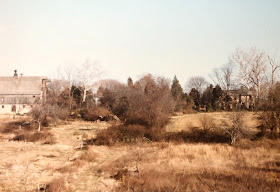 |
| Eastward-looking view of the old stone farm house (right) and 20th Century barns (left) |
I won't go too deeply into the Chillas family here, as they've already been mentioned in a previous post (you can also find good information here as well). The short version is that the Chillases were Scottish immigrants (Arthur by way of Liverpool, England) based out of Philadelphia, and Arthur was, at the time, president of the North American Coal Company. He probably bought Roseville as a business proposition, although the 1843 ad does seem to imply he was living there, at least for a short time. By 1850 Arthur was living in a boarding house in Philadelphia. He was a widower, but his second wife (who he would marry in 1851) was listed 11 lines above him in the same boarding house.
As best as I can guess by looking at the 1850 Census, the operator of the Roseville Factory might have been a man named Edward Garrigues. He's listed as a Manufacturer, and the next 15 or so families are all in the textile industry (weaver, spinner, carder, etc.). Immediately after the them is Uriah Drake, the next farmer over, who lived in the Meeteer House (now the Yasik Funeral Home). As best as I can tell, Garrigues was a pharmacist in Philadelphia, so he may have known Chillas from there and been brought in to supervise the factory.
